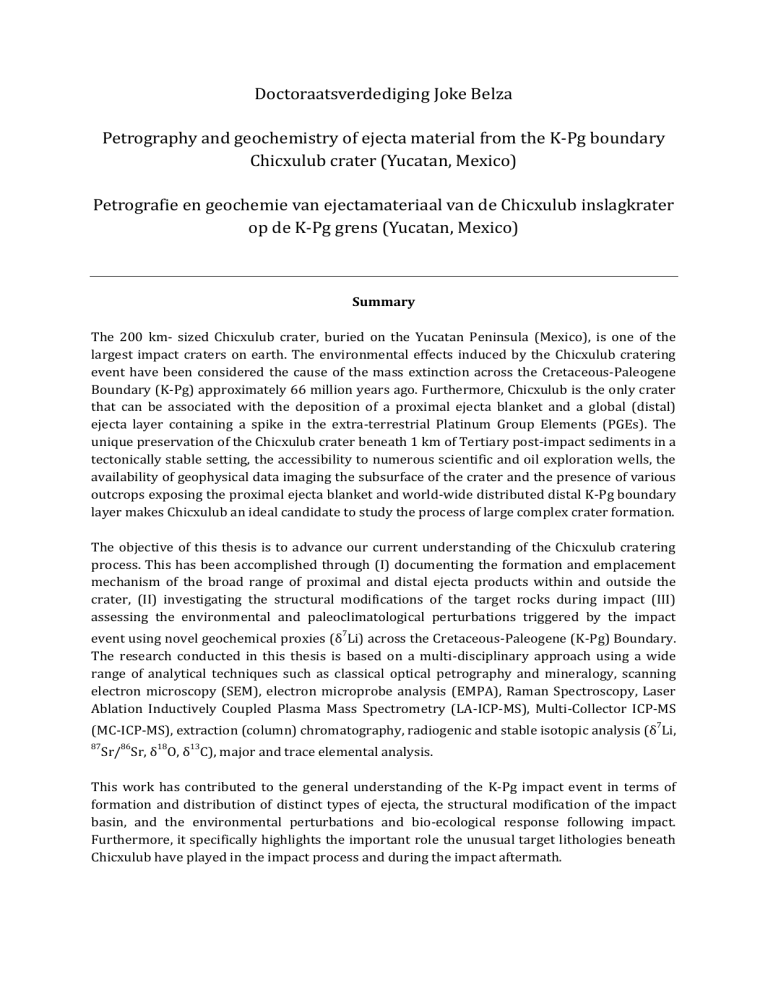
Doctoraatsverdediging Joke Belza
Petrography and geochemistry of ejecta material from the K-Pg boundary
Chicxulub crater (Yucatan, Mexico)
Petrografie en geochemie van ejectamateriaal van de Chicxulub inslagkrater
op de K-Pg grens (Yucatan, Mexico)
Summary
The 200 km- sized Chicxulub crater, buried on the Yucatan Peninsula (Mexico), is one of the
largest impact craters on earth. The environmental effects induced by the Chicxulub cratering
event have been considered the cause of the mass extinction across the Cretaceous-Paleogene
Boundary (K-Pg) approximately 66 million years ago. Furthermore, Chicxulub is the only crater
that can be associated with the deposition of a proximal ejecta blanket and a global (distal)
ejecta layer containing a spike in the extra-terrestrial Platinum Group Elements (PGEs). The
unique preservation of the Chicxulub crater beneath 1 km of Tertiary post-impact sediments in a
tectonically stable setting, the accessibility to numerous scientific and oil exploration wells, the
availability of geophysical data imaging the subsurface of the crater and the presence of various
outcrops exposing the proximal ejecta blanket and world-wide distributed distal K-Pg boundary
layer makes Chicxulub an ideal candidate to study the process of large complex crater formation.
The objective of this thesis is to advance our current understanding of the Chicxulub cratering
process. This has been accomplished through (I) documenting the formation and emplacement
mechanism of the broad range of proximal and distal ejecta products within and outside the
crater, (II) investigating the structural modifications of the target rocks during impact (III)
assessing the environmental and paleoclimatological perturbations triggered by the impact
7
event using novel geochemical proxies (δ Li) across the Cretaceous-Paleogene (K-Pg) Boundary.
The research conducted in this thesis is based on a multi-disciplinary approach using a wide
range of analytical techniques such as classical optical petrography and mineralogy, scanning
electron microscopy (SEM), electron microprobe analysis (EMPA), Raman Spectroscopy, Laser
Ablation Inductively Coupled Plasma Mass Spectrometry (LA-ICP-MS), Multi-Collector ICP-MS
7
(MC-ICP-MS), extraction (column) chromatography, radiogenic and stable isotopic analysis (δ Li,
87
86
18
13
Sr/ Sr, δ O, δ C), major and trace elemental analysis.
This work has contributed to the general understanding of the K-Pg impact event in terms of
formation and distribution of distinct types of ejecta, the structural modification of the impact
basin, and the environmental perturbations and bio-ecological response following impact.
Furthermore, it specifically highlights the important role the unusual target lithologies beneath
Chicxulub have played in the impact process and during the impact aftermath.
Samenvatting
De Chixculub krater ligt begraven op het Yucatan Schiereiland (Mexico) en is met zijn diameter
van 200 km een van de grootst gekende inslagkraters op aarde. De ecologische verstoringen
teweeggebracht door het inslaggebeuren worden beschouwd als de oorzaak van de massaextinctie langsheen de Krijt-Paleogeen grens ongeveer 66 miljoen jaar geleden. The Chicxulub
krater is tevens de enige inslagstructuur die geassocieerd kan worden met de afzetting van een
proximaal ejectadeken en een globale (distale) ejectalaag aangerijkt in de extra-terrestrische
platinum groep elementen (PGE’s). Het unieke behoud van de Chicxulub krater onder een 1 km
dikke laag van Tertiaire post-inslag sedimenten in een tektonisch weinig actieve omgeving, de
toegankelijkheid van talrijke boringen (zowel voor wetenschappelijke doeleinden als in de olieexploratie industrie), de beschikbaarheid van geofysische gegevens die de ondergrondse
structuur in kaart brachten en de aanwezigheid van verscheidene ontsluitingen van zowel het
proximale ejectadeken als de globale (distale) K-Pg grenslaag maakt van Chicxulub een
typevoorbeeld voor het bestuderen van een complexe inslagkrater.
Het doel van deze scriptie omvat het bevorderen van onze huidige kennis omtrent de vorming
van de Chixculub krater. Dit werd verwezenlijkt enerzijds door (I) het documenteren en
karakteriseren van de brede waaier aan proximale en distale ejecta-afzettingen binnenin en
buiten de krater, (II) het bestuderen van de structurele veranderingen in het target-gesteente
geaffecteerd door de inslag, en (III) het taxeren van de ecologische en paleo-klimatologische
verstoringen als gevolg van de inslag door het gebruik van nieuwe geochemische proxies (δ7Li)
langsheen de Krijt-Paleogeen grens. Het onderzoek in dit proefschrift is gebaseerd op een
multidisciplinaire aanpak met behulp van een breed scala van analytische technieken zoals
klassieke optische petrografie en mineralogie, scanning elektronenmicroscopie (SEM),
electronen microprobe analyse (EMPA), Raman spectroscopie, laser ablatie inductief-gekoppeld
plasma massaspectrometrie (LA-ICP-MS), multi-collector inductief-gekoppeld plasma massaspectrometrie (MC-ICP-MS), extractie (kolom) chromatografie, analyse van radiogene en
stabiele isotopen (δ7Li, 87Sr/86Sr, δ18O, δ13C), alsook hoofd- en spoorelementanalyse.
Dit werk heeft bijgedragen tot de algemene kennis van het meteorietinslaggebeuren op de K-Pg
grens, meebepaald met betrekking tot de vorming en distributie van verschillende soorten
ejecta, de structureel-tektonische veranderingen van het inslagbekken, en de bio -ecologische
respons na de inslag. Voorts benadrukt dit werk de cruciale rol van de volatiele target gesteentes
tijdens en in de nasleep van het inslagproces.











